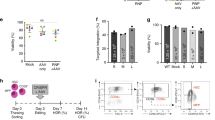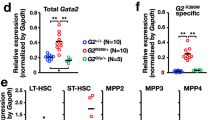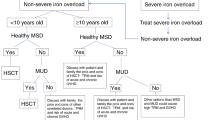Abstract
Chédiak–Higashi syndrome is a rare autosomal recessive disorder, primarily affecting neutrophils, and is often lethal by the third decade of life. Bone marrow transplantation is the only curative therapy currently available. This case describes a child undergoing a bone marrow transplant from a matched sibling donor, resulting in hematopoietic chimerism with only a small percentage of donor neutrophils found long term. The presence of a small percentage of donor neutrophils has resulted in normal development and no increased incidence of infections. Hematopoietic chimerism offers a cure with a potential reduction in the side-effects that result from marrow transplantation and the associated preparative therapies. Bone Marrow Transplantation (2001) 27, 1211–1213.
This is a preview of subscription content, access via your institution
Access options
Subscribe to this journal
Receive 12 print issues and online access
$259.00 per year
only $21.58 per issue
Buy this article
- Purchase on Springer Link
- Instant access to full article PDF
Prices may be subject to local taxes which are calculated during checkout
Similar content being viewed by others
References
Miller DR, Baehner RL . Blood Diseases of Infancy and Childhood Mosby: St Louis 1995 pp 593–626
Jandl JH . Textbook of Hematology Little, Brown and Company: Boston 1996 pp 785–802
Haddad E, Le Deist F, Blanche S et al. Treatment of Chédiak–Higashi syndrome by allogeneic bone marrow transplantation: report of ten cases Blood 1995 85: 3328–3333
Peters CP, Balthazor M, Shapiro EG et al. Outcome of unrelated donor bone marrow transplantation in forty children with Hurler syndrome Blood 1996 87: 4894–4902
Storb R, Yu C, Wagner JL et al. Stable mixed hematopoietic chimerism in DLA-identical littermate dogs given sublethal total body irradiation before and pharmacological immunosuppression after marrow transplantation Blood 1997 89: 3048–3054
McSweeney PA, Storb R . Mixed chimerism: preclinical studies and clinical applications Biol Blood Marrow Transplant 1999 5: 192–203
Ortega M, Escudero T, Caballín MR et al. Follow-up of chimerism in children with hematological diseases after allogeneic hematopoietic progenitor cell transplants Bone Marrow Transplant 1999 24: 81–87
Coccia PF, Strandjord SE, Warkentin PI et al. High-dose cytosine arabinoside and fractionated total-body irradiation: an improved preparative regimen for bone marrow transplantation of children with acute lymphoblastic leukemia in remission Blood 1988 71: 888–893
Boxer LA, Watanabe AM, Rister M et al. Correction of leukocyte function in Chédiak–Higashi syndrome by ascorbate New Engl J Med 1976 295: 1041–1045
Barak Y, Nir E . Chédiak–Higashi syndrome Am J Ped Hematol Oncol 1987 9: 42–55
Author information
Authors and Affiliations
Rights and permissions
About this article
Cite this article
Trigg, M., Schugar, R. Chédiak–Higashi syndrome: hematopoietic chimerism corrects genetic defect. Bone Marrow Transplant 27, 1211–1213 (2001). https://doi.org/10.1038/sj.bmt.1703058
Received:
Accepted:
Published:
Issue Date:
DOI: https://doi.org/10.1038/sj.bmt.1703058



